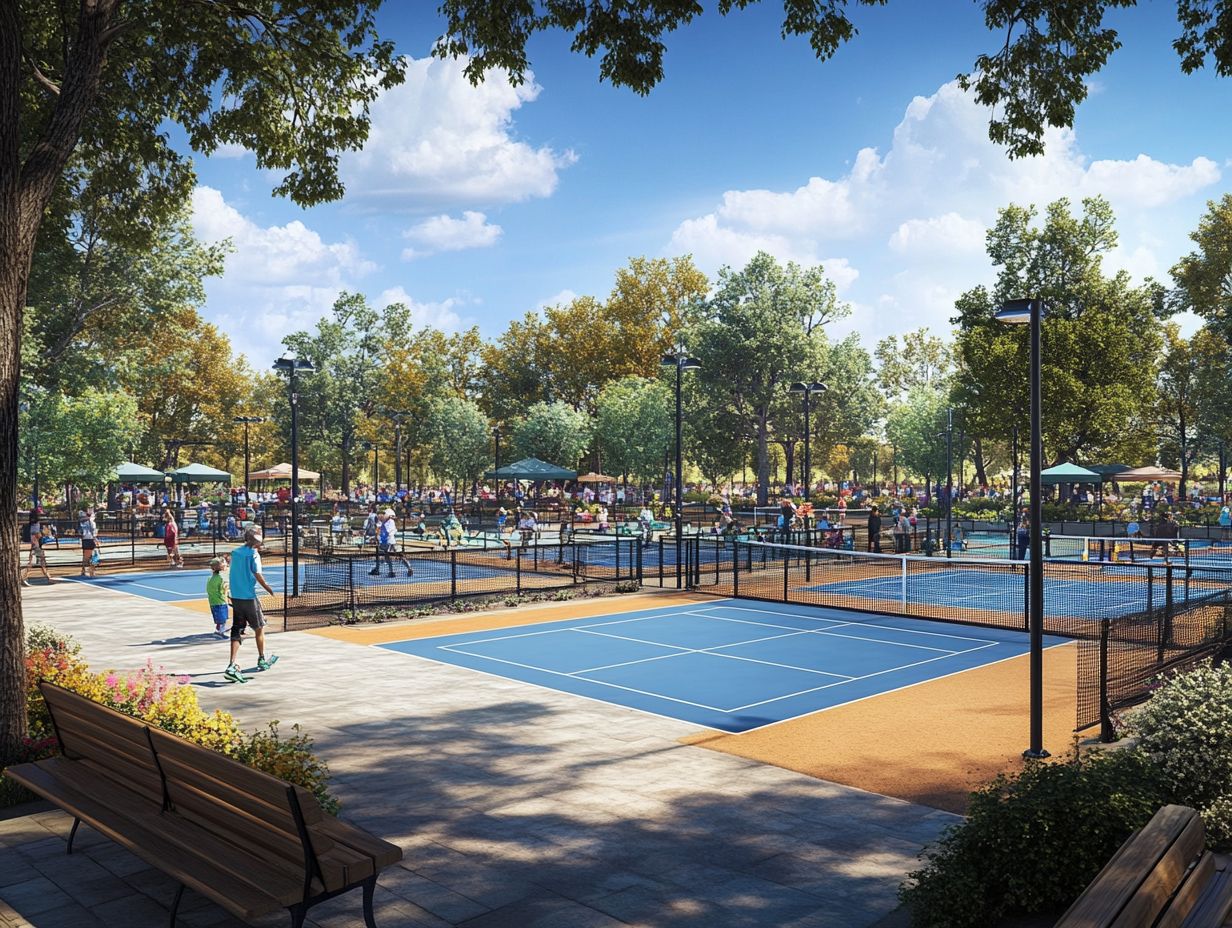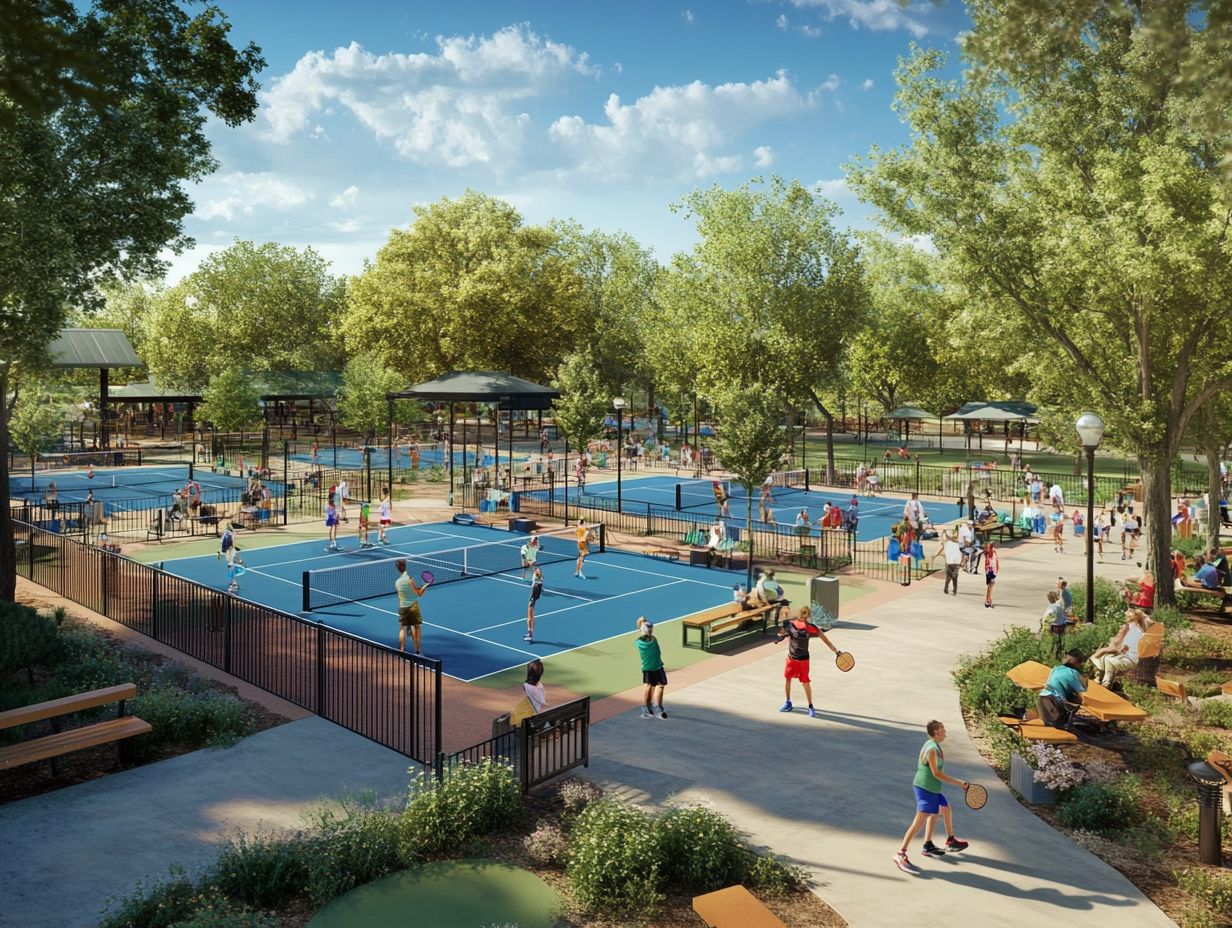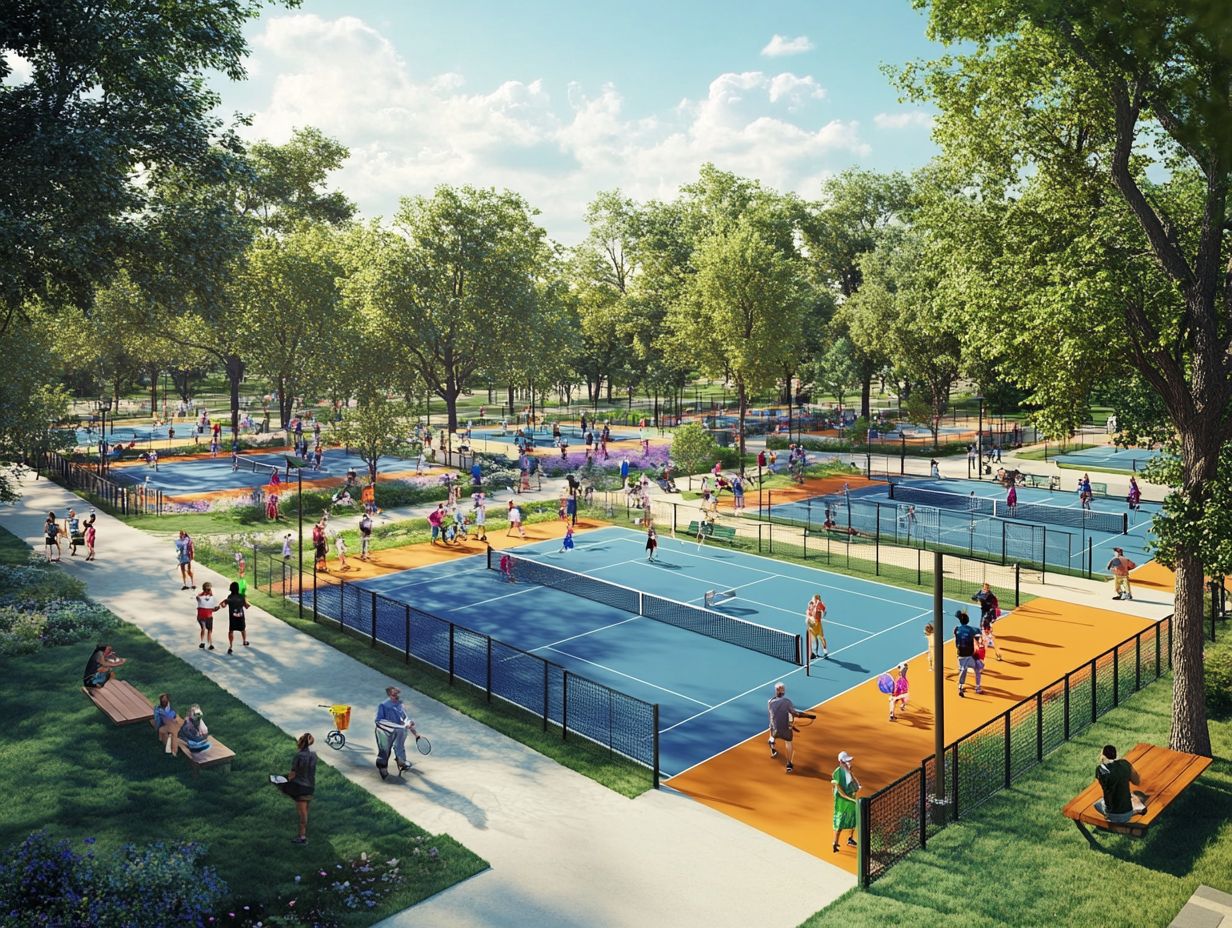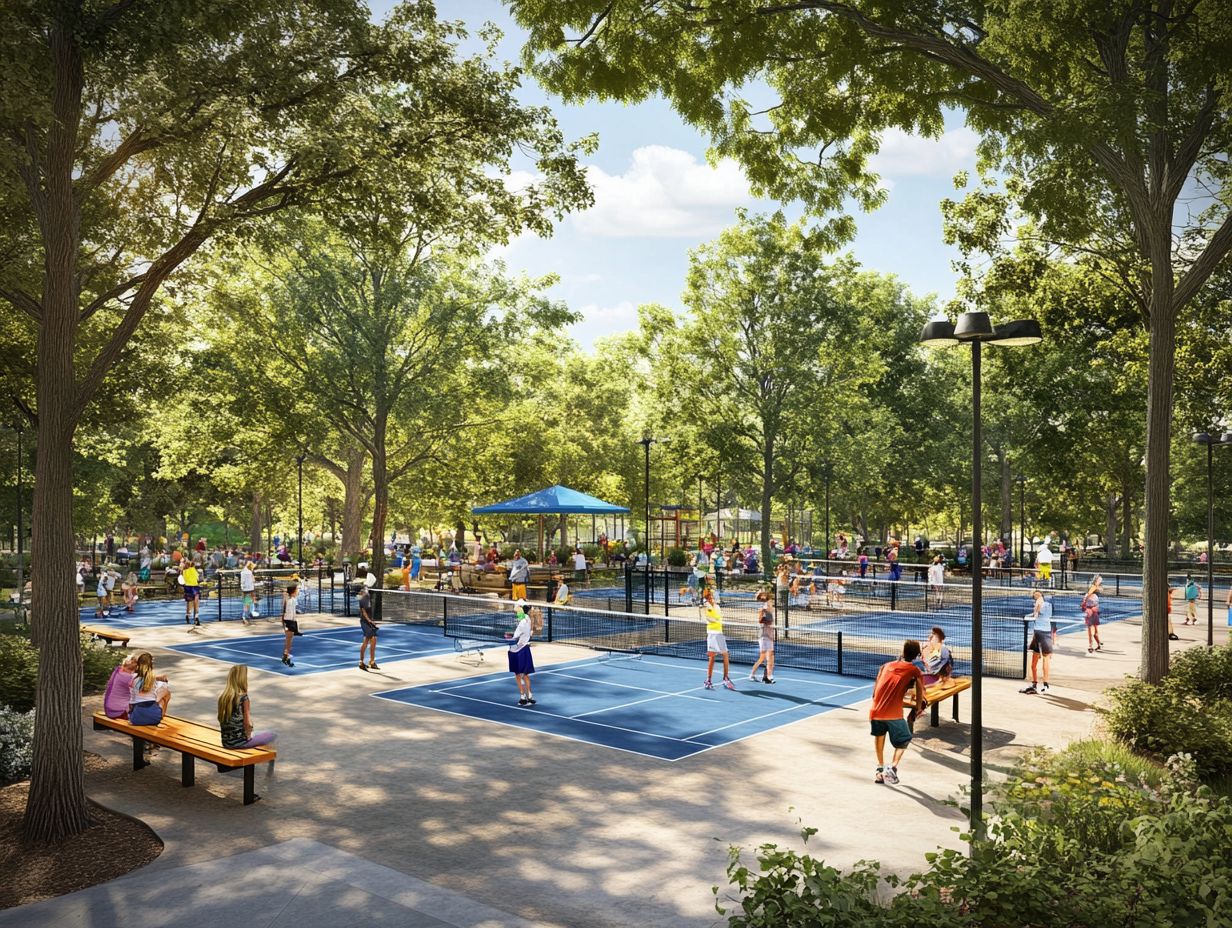Pickleball is not only an enjoyable sport; it is also transforming communities and enhancing local economies. With its fascinating history and evolution, the game plays a vital role in fostering social connections and promoting inclusivity, making it a hub for engagement.
This sport stimulates local businesses and creates jobs while addressing the challenges faced by expanding pickleball communities.
Explore the diverse impact of this vibrant sport on our lives.
Understanding Pickleball

Pickleball is a rapidly growing sport that combines elements of tennis, badminton, and table tennis, making it accessible to players of all ages and skill levels.
Established in the mid-20th century, the sport has evolved significantly, reflecting demographic trends and a growing emphasis on community engagement through recreational activities.
Its popularity can be attributed to its inclusive nature, which encourages social interaction and fosters community cohesion, all while promoting the health benefits associated with physical activity.
History and Evolution of the Sport
The history of pickleball began in 1965 when three fathers created the sport as a summer activity to entertain their bored children. Since then, it has evolved into a popular sport with a strong community identity and vibrant grassroots movements.
Over the decades, this seemingly simple pastime gained traction across communities, becoming a symbol of camaraderie and health. Pioneers of the sport, such as the founders of the USA Pickleball Association, played a crucial role in organizing tournaments and standardizing the rules, both of which contributed to its formalization and appeal.
The establishment of national championships sparked interest among players nationwide, transforming what was once an informal summer pastime into a competitive sport. This evolution fostered friendly competition and created bonds among diverse groups and individuals who shared a love for the game, as they came together to establish clubs and leagues that nurtured a strong sense of community.
These opposing yet complementary aspects of the game’s development illustrate how something that started as a simple form of entertainment has fostered long-lasting connections and encouraged healthy lifestyles.
Community Impact of Pickleball

The impact of pickleball on the community is significant, as it promotes social interaction among individuals from diverse backgrounds, encourages community events, and facilitates family activities.
These aspects collectively strengthen community ties and foster a sense of pride within the community.
Promoting Social Connections and Inclusivity
Pickleball fosters social connections and inclusivity by providing opportunities for individuals from diverse backgrounds to engage in enjoyable, active recreation together. This, in turn, promotes community outreach and encourages volunteering.
The sport serves as a welcoming platform for people of all ages to learn, play, and socialize, creating an excellent environment for building relationships. Its straightforward rules and flexible nature allow even those who are unaccustomed to sports to participate with confidence.
As players bond over shared experiences, they form connections that transcend social barriers, nurturing a sense of inclusion. This level of inclusivity not only benefits individuals but also strengthens local communities.
Additionally, the collaborative nature of pickleball often inspires community members to volunteer and contribute to local initiatives, whether through organizing events or teaching others how to play.
Economic Benefits of Pickleball

The economic benefits of pickleball are evident in the increased development of tourism, the creation of new business opportunities, and investments in recreational infrastructure, all of which contribute to overall community development.
Boosting Local Businesses and Tourism
Pickleball significantly boosts local businesses and tourism by attracting players and spectators to community events, thereby generating a substantial economic impact that supports local economies and caters to diverse player demographics.
The sport has rapidly gained popularity, appealing to a wide range of participants, from young athletes to seniors seeking an enjoyable and engaging way to stay active. As local tournaments and leagues thrive, they not only capture the attention of residents but also draw in out-of-town visitors, which stimulates local hotel bookings, dining establishments, and retail shops.
Economic impact studies have shown that these events can lead to increased revenue streams, with local investments in facilities and amenities yielding lasting benefits. Ultimately, the positive ripple effects highlight how pickleball acts as a catalyst for vibrant local economies.
Job Creation and Revenue Generation

The growth of pickleball has created jobs and generated revenue by increasing demand for recreational leagues, professional coaching, and facility investments, which in turn support community resources and drive economic revitalization.
This surge in popularity has positively impacted the local economy and fostered a sense of community as facilities are constructed or upgraded to accommodate larger groups. Local businesses benefit from increased foot traffic, leading to higher sales for restaurants, shops, and equipment suppliers.
The demand for certified coaches and trainers is also creating numerous job opportunities in these fields. Additionally, community centers and schools are incorporating the sport into their programs, helping to bring people together and engage them while revitalizing local spaces that may have fallen into disuse.
This combination of health, community engagement, and growth is promising for the future of pickleball communities.
Challenges and Solutions for Pickleball Communities
Pickleball communities are encountering challenges, including limited recreational infrastructure and the need for effective community planning to accommodate the growing interest in the sport. Innovative solutions will be necessary to ensure both sustainability and accessibility.
Addressing Space and Facility Limitations
To address space and facility limitations for pickleball, it is essential to invest in facilities, optimize urban design, and foster public-private partnerships to ensure that venues are accessible to all players.
Investing in multi-purpose courts that accommodate various activities can enhance utilization, while hosting diverse events at these venues can increase community engagement.
Public-private partnerships will play a critical role in developing dedicated pickleball facilities, ensuring that the sport remains accessible to a wide demographic.
Additionally, developing facilities on underutilized land is a key strategy for promoting healthy lifestyles and encouraging interaction among different demographic groups, all while addressing the growing demand for pickleball facilities.
Ensuring Sustainability and Accessibility
Sustainability and accessibility within pickleball communities are crucial for the sport’s long-term growth and can be effectively achieved through community outreach programs and volunteerism that engage individuals from all demographics in inclusive ways.
By developing community outreach programs in collaboration with local organizations and schools, we can create opportunities for people of diverse backgrounds to experience the benefits and enjoyment of pickleball. Volunteers can play a vital role in these outreach initiatives by coordinating events that introduce communities to the sport, serving as mentors for new players or those unfamiliar with racquet sports, and ensuring that facilities are well-maintained, welcoming, and accessible to everyone.
Forming partnerships with health and wellness initiatives can further position pickleball as an inclusive option for maintaining a healthy and active lifestyle, particularly for underrepresented demographics. This collaborative approach not only increases participation levels but also fosters sustainability within the community, ensuring that pickleball remains a viable sport for future generations.

Pickleball’s more than a game to me—it’s a passion. I write, sharing its highs and lows, the thrills and the lessons. Some tales might draw you to the court, while others give a hint of the game’s magic. So, curious about my journey? Ready to dive deep into the world of pickleball with me? Let’s go.
